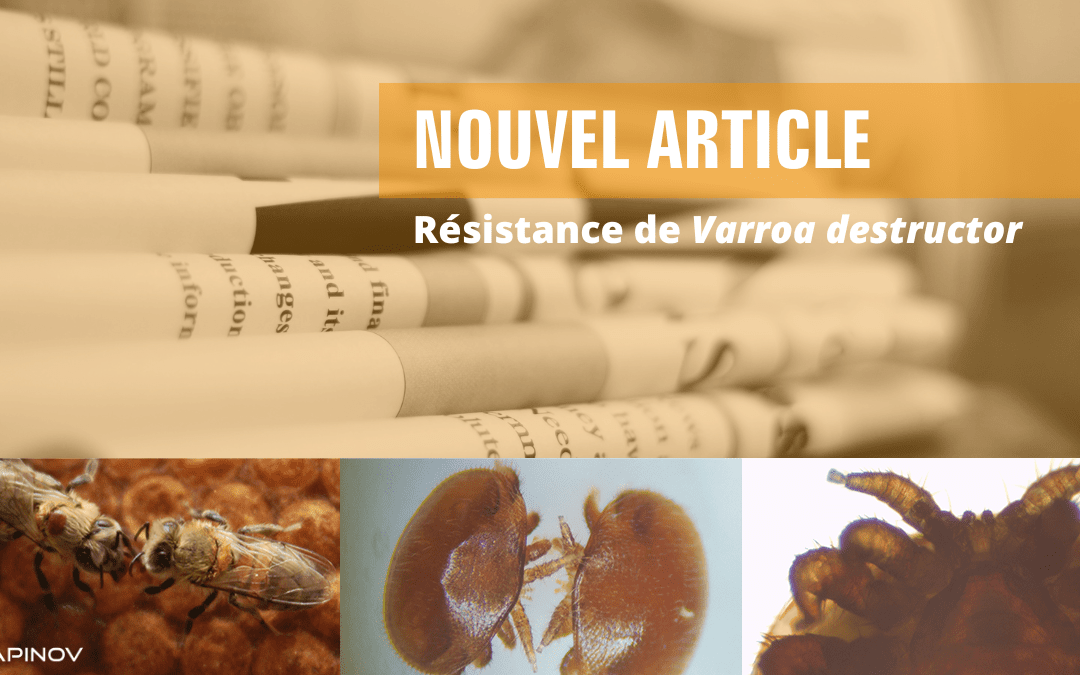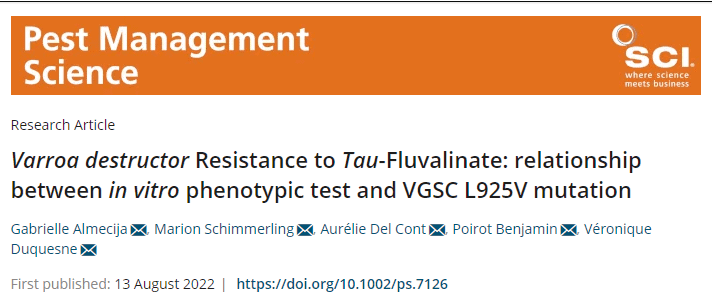Lecture scientifique de l'été !
L’article sur la résistance des varroas, suite à la thèse de Gabrielle Almecija, en collaboration avec l’Anses, vient d’être publié. Découvrez le résumé dans Pest Management Science, traduit par nos soins ci-dessous. Pour retrouver l’intégralité de l’article, il faudra encore patienter quelques jours !
CONTEXTE
Varroa destructor est un acarien parasite de l’abeille domestique, Apis mellifera. Sa présence en colonies peut entraîner un effondrement en quelques années. L’utilisation d’acaricides est devenue indispensable pour gérer l’infestation de la ruche. Cependant, l’utilisation répétée et éventuellement erronée de traitements acaricides, comme le Tau-fluvalinate, a conduit au développement de résistances. Le test phénotypique in vitro permet de connaître la proportion d’individus sensibles ou résistants suite à une exposition à une substance active. Chez les acariens Varroa, la résistance au tau-fluvalinate est associée à la présence de mutations en position 925 de la protéine du canal sodique voltage-dépendant (VGSC).
RÉSULTATS
Dans cette étude, nous avons comparé les résultats obtenus avec un test phénotypique in vitro contre le tau-fluvalinate et ceux obtenus avec un test de discrimination allélique (test génétique) sur 13 populations de Varroa traitées et non traitées en France. La corrélation entre le phénotype et le taux de profil génétique s’avère très bonne (0,89). Les varroas ayant un profil phénotypique résistant ont une probabilité de 63% de présenter la mutation L925V (fiabilité de détection de résistance). En revanche, 97% des acariens Varroa ayant le phénotype sensible ne présentent pas la mutation L925V (fiabilité de détection sensible).
CONCLUSION
La mutation L925V explique l’essentiel de la résistance au tau-fluvalinate chez Varroa destructor dans les populations testées en France. Cependant, d’autres mutations ou types de résistance peuvent également intervenir pour expliquer la survie des varroas dans le test phénotypique. Les 2 tests sont donc complémentaires et permettent de suivre l’évolution des résistances.
BACKGROUND
Varroa destructor is a parasitic mite of the honey bee, Apis mellifera. Its presence in colonies can lead to a collapse within a few years. The use of acaricides has become essential to manage the hive infestation. However, the repeated and possibly incorrect use of acaricide treatments, as Tau-fluvalinate, has led to the development of resistance.. The in vitro phenotypic test allows to know the proportion of susceptible or resistant individuals following a exposure to an active substance. In Varroa mites, resistance to tau-fluvalinate is associated with the presence of mutations at the position 925 of the voltage-gated sodium channel (VGSC).
RESULTS
Here, we compared the results obtained with an in vitro phenotypic test against tau-fluvalinate and those obtained with an allelic discrimination assay on 13 treated and untreated Varroa populations in France. The correlation between the phenotype and the genetic profile rate is found to be 0.89 Varroa mites having resistant phenotypic profile have a probability of 63% to present the L925V mutation (resistance detection reliability). On the other hand, 97% of the Varroa mites having the susceptible phenotype do not present the L925V mutation (susceptible detection reliability).
CONCLUSION
The L925V mutation explains most of the resistance to tau-fluvalinate in Varroa destructor in the populations tested. However, other mutations or types of resistance may also be involved to explain the survival of Varroa mites in the phenotypic test.
Almecija, G., Schimmerling, M., Cont, A.D., Benjamin, P. and Duquesne, V. (2022), Varroa destructor Resistance to Tau-Fluvalinate: relationship between in vitro phenotypic test and VGSC L925V mutation. Pest Manag Sci. Accepted Author Manuscript.

